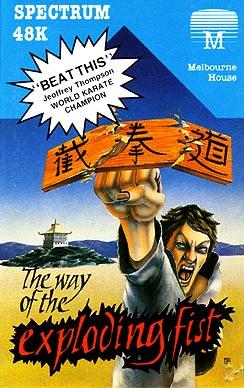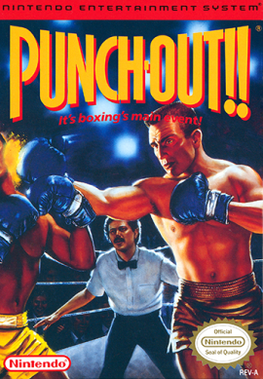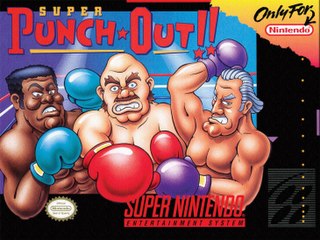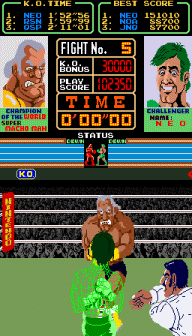
The Way of the Exploding Fist is a 1985 fighting game based on Japanese martial arts developed by Beam Software, by a team consisting of Gregg Barnett, Bruce Bayley, Neil Brennan and David Johnston. Originally developed on the Commodore 64 and published in June 1985 by Melbourne House, ports were made for Amstrad CPC, ZX Spectrum, BBC Micro, Acorn Electron and Commodore 16.

Chase H.Q. is a vehicular combat racing game, originally released as an arcade video game by Taito in 1988. It is sometimes seen as a spiritual successor to Taito's earlier Full Throttle. The player assumes the role of a police officer named Tony Gibson, member of the "Chase Special Investigation Department". Along with his partner, Raymond Broady, he must stop fleeing criminals in high-speed pursuits in a black Porsche 928.

Punch-Out!!, is a 1987 boxing video game developed and published by Nintendo for the Nintendo Entertainment System (NES). Part of the Punch-Out!! series, it is an adaptation of the arcade video games Punch-Out!! (1984) and Super Punch-Out!! (1984). Differences from the arcades include the addition of undisputed world heavyweight champion Mike Tyson as the final boss. It received critical acclaim, and is retrospectively considered one of the greatest video games of all time.

Punch-Out!! is an 1984 arcade boxing video game developed by Nintendo R&D3 and published by Nintendo. It was the inaugural game in the Punch-Out!! series.

Super Sprint is a racing video game released by Atari Games and Midway Games in 1986. Up to three players drive Formula One-like cars on a circuit that is viewed from above. The game is a successor to Gran Trak 10 and the Sprint series, which were black-and-white games from the 1970s. A sequel, Championship Sprint, was released later in the same year.

Kung-Fu Master, known as Spartan X in Japan, is a side-scrolling beat 'em up developed by Irem and released as an arcade video game in 1984. It was distributed by Data East in North America. Designed by Takashi Nishiyama, the game was based on Hong Kong martial arts films. It is a loose adaptation of the Jackie Chan, Sammo Hung and Yuen Biao film Wheels on Meals (1984), called Spartan X in Japan, with the protagonist Thomas named after Jackie Chan's character in the film. The game is also heavily inspired by the Bruce Lee film Game of Death (1972), which was the basis for the game's concept. Nishiyama, who had previously designed the side-scrolling shooter Moon Patrol (1982), combined fighting elements with a shoot 'em up gameplay rhythm. Irem and Data East exported the game to the West without the Spartan X license.

Ghosts 'n Goblins, known as Makaimura in Japan, is a platform video game developed by Capcom and released for arcades in 1985. It is the first game in the Ghosts 'n Goblins franchise, and has since been ported to numerous home platforms.

Smash TV is a 1990 arcade video game created by Eugene Jarvis and Mark Turmell for Williams Electronics Games. It is a twin-stick shooter in the same vein as 1982's Robotron: 2084, which was also co-created by Jarvis. The Super Nintendo Entertainment System, Genesis, Master System, and Game Gear versions are titled Super Smash TV.

Super Punch-Out!! is a boxing video game developed and published by Nintendo for the Super Nintendo Entertainment System (SNES). It was released on October 24, 1994 in North America and again in the same region in 1996. It was released in the United Kingdom on February 10, 1995 for the same console and in Japan in 1998 for the Super Famicom through the Nintendo Power flash RAM cartridge series. The game is also included in the GameCube version of Fight Night Round 2 as an extra game due to the inclusion of Little Mac in the game. The game was released for the Wii's Virtual Console in Europe on March 20, 2009, in North America on March 30, 2009, and in Japan on July 7, 2009. The game was also released on the New Nintendo 3DS eShop on May 5, 2016. Nintendo re-released Super Punch-Out!! in the United States in September 2017 as part of the company's Super NES Classic Edition. It is the fourth game in the Punch-Out!! series, taking place after the Punch-Out!! game for the Nintendo Entertainment System (NES).

Wonder Boy is a 1986 platform game published by Sega and developed by Escape. Originally designed for arcades, it was later ported to the SG-1000, Mark III/Master System and Game Gear video game consoles by Sega, and to the ZX Spectrum, Commodore 64 and Amstrad CPC home computers by Activision. The game is also known as Super Wonder Boy for its Sega Mark III release in Japan and Revenge of Drancon for its Game Gear release in North America. A high definition remake of the game, titled Wonder Boy Returns, was developed by CFK and released on Steam on October 12, 2016. Wonder Boy was rereleased in 2022 as part of Wonder Boy Collection for the Nintendo Switch and PlayStation 4 which includes its versions on arcade, Master System, SG-1000 and Game Gear.

Barry McGuigan World Championship Boxing is a British video game released in 1985 for the Amstrad CPC, Commodore 64, Thomson MO5 and ZX Spectrum by the Gamestar branch of Activision and later re-released by Mastertronic. It was titled Star Rank Boxing in the US.

Quartet (カルテット) is a run and gun video game released by Sega for arcades in 1986. Quartet allows one to four players to guide a set of characters through a base taken over by an army of robots. Players control either Joe (yellow), Mary (red), Lee (blue), or Edgar (green) across 32 side-scrolling levels. The object of the game is to advance through the level, fighting opponents that come out of portals in the walls, and eventually defeat a boss that carries the door key used to open the "exit door" for the level.

WWF WrestleMania is a game developed by Twilight and published by Ocean Software in 1991 for the Amiga, Amstrad CPC, Atari ST, Commodore 64, ZX Spectrum, and DOS. Named after the World Wrestling Federation's (WWF) annual pay-per-view event WrestleMania, it was the first WWF licensed game available for these computers which were still dominant in Europe. It was followed on most of these computers by 1992's WWF European Rampage Tour.

Thunder Blade is a third-person shoot 'em up video game released by Sega for arcades in 1987. Players control a helicopter to destroy enemy vehicles. The game was released as a stand-up arcade cabinet with force feedback, as the joystick vibrates. A helicopter shaped sit-down model was released, replacing the force feedback with a cockpit seat that moves in tandem with the joystick. It is a motion simulator cabinet, like the previous Sega Super Scaler games Space Harrier (1985) and After Burner (1987). The game's plot and setting was inspired by the film Blue Thunder (1983).

Punch-Out!! is a boxing video game series created by Nintendo's general manager Genyo Takeda, and his partner Makoto Wada. It was originally created because Nintendo had too many TV screens lying around in their warehouse, due to buying an abundance of them after the success of Donkey Kong. Genyo Takeda was consulted as to what to make, and he suggested a boxing game. Thus Punch-Out!! was born.
Quattro is a series of video game compilations released in the 1990s. They consisted of games developed by Codemasters. The NES versions were released as multicarts and were published by Camerica without a license by Nintendo.
Tiertex Design Studios Limited was a British software development company and former video game developer based in Macclesfield, England; it was founded in 1986, focusing on porting games to home computers and handheld platforms.

Cosmo Police Galivan is a single-player, shoot-em-up arcade video game developed and released worldwide by Nichibutsu. The game is a homage to the Japanese tokusatsu shows Space Sheriff Gavan and Space Sheriff Sharivan. It was later ported to Commodore 64, Amstrad CPC, ZX Spectrum, and Famicom. The game is included in the Arcade Archives series for PlayStation 4 and Nintendo Switch. The game has a sequel on Super Nintendo Entertainment System, called Cosmo Police Galivan II: Arrow of Justice.
















